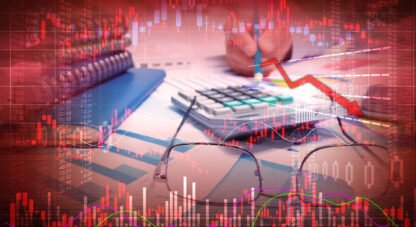Podcast: Play in new window
- Is the Fed losing its excuse to pump in $120 billion in QE per month?
- Vaccine Immunity: All profit & no liability for big drug companies
- Bond ETFs – Bank of International Settlements concerned
Forever FED? Emergency Bailout Now The Norm
August 25, 2021
“Politicians never let a crisis go to waste, whether it’s real or not real, the crises we’ve seen over a 50-year period, you’d say opportunity is opportunity. If you never imagined modern monetary theory gaining traction, you just don’t know how that gets done because it’s an absurd idea, there is an existential threat which changes the character of the conversation. It changes the debate on the issue of financial conservatism versus fiscal largesse.” — David McAlvany
Kevin: Welcome to the McAlvany Weekly Commentary. I’m Kevin Orrick, along with David McAlvany.
I looked up today before we started, because I had been talking to you about the forever virus. You brought that up that in Foreign Affairs, they had an article that, hey, this virus isn’t going to go away. There’s too many opportunities. They didn’t say that part. But now we’re looking at the forever vaccine because of the Israel studies. We had the forever war in the Middle East that just suddenly ended. I think there was an awful lot of dependency on the forever war.
With all these forevers, including the forever Fed intervention, emergency intervention, now we’re on the 12th or 13th year of the emergency intervention for the Fed. I looked up songs— I was thinking of some songs, Strawberry Fields Forever—strawberry fields forever. Randy Travis, one of my favorites—forever and ever amen. Now I’m not quite the singer that Randy is and Kiss had a song called Forever. Bob Dylan had a song called—
David: Can you sing that song by Kiss?
Kevin: That one I can’t, I can’t. Bob Dylan, Forever Young. We do have some forevers out there, but the forever virus, the forever vaccine, the forever war, the forever Fed intervention. I think we ought to talk about this because what we saw last week, Dave, about a week and a half ago was what happens when dependency on forever gets taken away. Let’s talk about that today if we could.
David: I got to read a little bit of Joseph Tainter’s The Collapse of Complex Societies and the things that you think are forever, even empires.
Kevin: He was a great guest. He was an interesting guy.
David: That is one of the archives that could be worth going back to, if you’re not going to take the time to order the book and read it. It is, I think, a very important read. But the argument is that there’s complexity, and the more complexity there is, the higher the cost to maintain a system, where ultimately the economics just don’t work. The more complex a society gets, the higher cost to maintain, and ultimately people either move on or it collapses.
Kevin: Well, let’s talk about $120 billion monthly from the forever Fed intervention. Now, they can’t blame that on employment anymore, right? Because employment, the numbers are getting good enough, actually, where the Fed is going to have to come up with another reason to give us that 120 billion forever feed.
David: In July the monthly employment rate fell to 5.4%, and we’ve got job vacancies sitting right at around 10 million. There’s a Harvard economist, Jason Furman, the Financial Times was quoting him, and he said, “I have yet to find a blemish in this job’s report. I’ve never seen such a wonderful set of economic data.”
Kevin: And the Fed is going “shut up, shut up.”
David: This is a guy who teaches the dismal science, and he’s almost enthusiastic. “I’ve never seen such a wonderful set of economic data.” He sounds like an evangelist. The key here is that the Fed has lost justification for maintaining that $120 billion in monthly purchases. So, yes, COVID cases have risen. Yes, Chinese markets offer consideration for turmoil in the credit markets. And then of course you’ve got Taiwan, which presents headaches for the US State Department. Yes, you have economic data which suggests slowing of global economic activity, as well as US economic activity. And there’s no abatement of inflation pressures. You bring those two things together, stagflation trends are gaining momentum, and there you have the Fed wanting an allowance to stay full QE engaged while at the same time needing to make plans to taper and give enough of a lead time so the markets don’t freak out when and if they do.
Kevin: Dave, we were down the street at a hotel. I remember when we had the taper tantrum a few years ago. The Fed decided that they were going to taper, and the stock market just went kapooey. They called it the taper tantrum.
We as a company actually had an afternoon meeting down at the hotel, like I said, down at the bottom of the hill, but they had a TV on, and you should have seen the faces of the commentators. You weren’t there, but we were watching the TV going, “I think we need to get back to the office, there is a true change in the market.” Can Powell— Powell’s going to be talking at the Jackson Hole meeting here soon. What’s he going to say? Can he actually start talking about taper?
David: Right. Powell’s comments at Jackson Hole, I don’t think they’re likely to be radical in nature. That doesn’t mean that the markets can’t pout, maybe even throw a tantrum, but August 27th is around the corner. That’s the meeting. Market players are going to watch for a shift in timeframes for the elimination of support to the mortgage backed securities market and the treasury market. It’s worth noting that the Fed now owns 64% of 10-year Treasuries and is influential, controlling roughly 70% of the Treasury market. Makes the bond market almost irrelevant.
Kevin: It makes it European for sure. Yeah.
David: The Fed’s Financial Stability Report in the second quarter, we may have mentioned this in Hard Asset Insights last Friday. Again, a good read if you want a weekend take, a one-page summary from our asset management crew. The Financial Stability Report in the second quarter noted that, “the combination of stretched valuations with very high levels of corporate indebtedness bear watching, because of the potential to amplify the effects of a repricing event.”
Kevin: I love how they word things, okay. What they’re talking about is a repricing event. What is a repricing event, Dave? That sounds like a crash.
David: That’s correct. That’s correct. A repricing event. Amplified effects of a repricing event. I spent a little time reading through the Bank of International Settlements quarterly review. There was some really interesting things from the first quarter. A topic that I thought fit the theme of amplification, and that was their coverage of bond ETFs.
Kevin: Let me ask you a question. I can understand an ETF for something that’s very narrow. Okay. There are even gold and silver ETFs. Bonds. There’s a number of types of bonds out there. How do you have an ETF that can just index the bond market and have liquidity with all those bonds?
David: And that I think is the issue, because not all ETFs are frail or flawed in their design. But bond ETFs are a curious financial construction, which appear to be fragile and virtually guarantee further Fed purchases and fixed income because of the implicit price amplification of illiquid holdings within the products themselves. So you don’t have a uniformity. I think one of the things that you could say about say the S&P 500 ETF is that it’s fairly straightforward. You understand there’s a number of things that go into the basket. It’s the same thing every time. And so what is the S&P 500 ETF? It’s the S&P 500. What is a bond ETF? Well, you don’t always have access to the same bonds in quantity when you need to expand the holdings. There’s a difference in maturities. There’s a difference in credit qualities. Those things are constantly in flux. The complexity goes up dramatically.
Kevin: I wonder how large that market is, because, going back to 2008, the crash, I don’t even think bond ETFs existed. Where are they now?
David: Yeah, the first exchange-traded fund was launched in the 80s, I believe.
Kevin: Okay. So they did exist, but it must have been a small market.
David: But the bond market didn’t really embrace the ETF construction until a lot later. If you go back to 2009, the total market of bond ETFs was at about $10 billion, so nothing to sneeze at, but now that market has expanded in scale to roughly $1.2 trillion.
Kevin: Serious money.
David: Again, when we talk about the financial construction, the fragility, and the idea that the Fed would have to step in, a part of it is because scale has changed, right? And there is of course, inside of these ETFs, illiquid assets. Someone’s going to get caught holding the bag when someone wants liquidity. Is it going to be the market makers? Is it going to be the individual investor? And that’s where what we saw in 2020 was basically a smoothing over of a disaster in real time.
So scale of the market is a consideration for any regulator, or if you’re talking about those who are regulating currency and credit, central banks. This is obviously a part of what’s noted in this report by the Bank of International Settlements. But more than scale is the difference between the underlying assets. You can have the value and the price at which they trade, two very different things. So no one minds a variance, if you’re talking about a premium, right? You’ve got the basic assets in the basket. And if they sell at a premium, a dollar asset selling for $1.10, nobody minds. But when the variance is lower, you end up with destabilization. A dollar asset selling for 90 cents, who wants to take the 10 cent hit?
So last spring, this forced the hand of the Fed. This is again 2020. Nothing’s changed since then in terms of the construction of bond ETFs, they do continue to grow in scale, but we can easily anticipate a repeat performance.
Kevin: Over a trillion dollars in bond ETFs, but the quandary there is most bonds are supposed to be held to maturity. This isn’t a short-term trading vehicle. What are the mechanics of a bond ETF and how do they manage that?
David: And yet that is what is implied in the ETF structure, where you have instant liquidity with the click of a mouse. And yet there’s these entities behind the mouse click, which are very important. You have your market makers, you have your authorized participants. These are groups that create the baskets that hold the underlying assets for purchase by the retail or institutional investor. They’re the ones who could get caught holding the bag.
But there’s also some incentive for them to do what they do. They get to look for the premiums and discounts on all the assets in the basket, and arbitrage the difference away. Arguably this creates liquidity. Arguably there is a motive for them to step in and be the market maker, taking some risk and pocketing the difference as profit, right?
The gaps are small with other forms of ETFs. You were talking about commodity ETFs and stock ETFs. Total ETF market is about 7 trillion. This is 1.2 trillion, the bond segment of it. And this is where all of a sudden you see the gaps are larger. Liquidity is a lot less. And again, we’ve mentioned this in previous commentaries, the ETF structure designed for shorter-term trades is mismatched with an investment in fixed income, which is meant, as you mentioned a minute ago, to be held usually to maturity.
Kevin: Okay. But it sounds to me like someone with special knowledge. I keep going back to the story that Jim Deeds told us when he first started in the municipal bond industry. Remember that? Jim would tell the story of how he went into the office and there were stacks of municipal bonds all through the CEO’s office of this company that he was interviewing for. They were municipal bonds that were waiting to find a home. What this guy did was he just basically bought them. They bought them, they held them. They were market makers, that’s what a market maker does. But it sounds to me like— 1.2 trillion. ETFs are they really matched for bonds unless you have a forever Fed that’ll just come in and buy it all?
David: Well, and this is where some of the complexity gets very interesting. As it turns out, the baskets that are created to help maintain liquidity for the bond ETFs, they have to change up what goes into the basket very routinely. It’s not your rubber stamp products, A, B, C, just like the last time. It might be X, Y, Z. It might be I, T, F. It might be whatever. Limited availability of exactly similar product is a constraint when demand is high. And on the other side of the equation, limited liquidity for the underlying assets become the mirror-like issue when liquidations pick up.
Kevin: So you’re telling me that the basket may not even be what people think that they’re holding. So tomayto, tomahto, potato.
David: That’s right. Potato stands in for tomato and you thought you were ordering a tomato, right? That’s what you thought. But the baskets that trade have only a small percentage of what they are actually supposed to have in them. Again, we go back to the authorized participant and the market makers, they agree on a case by case basis if the assets offered in substitute for the original model, if you will, are sufficient substitutes. Given the wide range of credit quality, maturity differences within the fixed income space, this is an ad hoc settlement with no automaticity, right? This raises a really key issue for me because structurally the authorized participant is there to create baskets for increased demand, or, on the other side of the equation, fill the middleman role as redemptions occur, buying back in the product, right? Ultimately selling off the underlying assets. But the arbitrage role, listen to this, the arbitrage role is not a contractual obligation. They can step away.
Kevin: Okay. I’m still thinking about this substitution, okay? If you don’t actually have the product, you come up with something that’s acceptable. I’ll never forget when my daughter was first born, my wife was in the toy store and there was a Taco Bell right next to the toy store. I heard on the speaker that they had run out of refried beans. Well, there is no substitute, Dave. Okay. When Taco Bell runs out of refried beans, it was hilarious. Because these people would pull through and they’re like sorry, sorry, we’re out of refried. They’d let them order first. And then they’d say, sorry, sorry. We’re out of refried beans. And there would be this unbelieving pause. How does Taco Bell run out of refried beans? But that’s what we’re talking about here. If you’ve got a group of guys who are just sitting around going, we don’t have the right bond, but this’ll do.
David: Well it’s like the authorized participants who put these baskets together have learned from the bureau of labor statistics. Substitutions are totally appropriate. If meat is too expensive, you can’t afford red meat anymore, that’s fine, we’ll go to lamb.
Kevin: Hold the pickles. Hold the lettuce. Special orders don’t upset us.
David: What’s the other white meat? Pork. What’s the other white meat? Maybe it’s chicken legs.
Kevin: How is this different than a garage sale guy where his specialty is to just buy something cheap and try to sell it for more? I don’t know. This whole ETF thing on bonds, I guess I hadn’t been paying attention.
David: The reality is you don’t know what’s in the sausage and the recipe is constantly changing. And to me it is a little bit like a Saturday morning garage sale guy. I know Drew, you know Drew. Drew for years was the Saturday morning garage sale guy.
Kevin: Let’s call it, it was more estate sales.
David: That’s true.
Kevin: I think that was the word he used.
David: That’s true. That’s true, in fairness. You step in and you find pricing differences, right? Maybe you see something that’s too cheap, you buy it. And maybe you’re going to use it. Maybe you’re going to resell it at the right price. But you recognize that there was a difference between what it was worth and what it was offered for. And so you fill the gap. It’s a Saturday morning arbitrage. That’s what these guys are there to do. In the bond ETF, the middleman buyer has limitations like the garage sale, sorry, estate sale hunter. You can’t buy everything and sometimes you don’t want to buy anything. But that’s not how the bond ETF is structured. It implies immediate liquidity with the click of a mouse even though the underlying assets are not always sellable. Lots of games, lots of substitutions in the baskets, ultimately lots of reasons for the Bank of International Settlements to care. In fact, I can count the reasons, 1.2 trillion reasons.
Kevin: Well, they don’t count on guys like you reading these reports, the Bank of International Settlements is sort of the bank for banks, right? And so they’re writing— this is sort of an inside professional document.
David: It’s helpful to appreciate where the risks lie. And if you’re in the financial markets, you need to appreciate what can blow up in your face and what pressures can emerge. For me, this dives back to Jackson Hole and this idea that we’re going to end involvement in interventions in the market, the $120 billion. If it ends this weekend or three weeks from now, I think the Fed is right back at it. And a part of it is because you’ve got products within the financial market, which necessitate a smoothing over. Because again, if your role—
Kevin: It necessitates forever Fed.
David: Exactly. And if your role in the market is to be the arbitrage guy, step in and create these baskets, but you don’t have to if you don’t want to. And if it looks you’re going to lose your shorts, you can just step back from the market. Then there’s no liquidity for these implied liquid products. Then what happens? Well, it requires the Fed to step in. Again, scale is an issue. Scale is a concern for the Bank of International Settlements, the assets under management of corporate bond ETFs.
And again, there’s a variety of bond ETFs. Just looking at corporate bonds, this is up 13 times, 13 times over the past 10 years. Just in corporate bonds, it’s $300 billion. Let’s not forget that, S&P Global counts all of your corporate debt, not just the stuff that gets put into ETFs, but all of your corporate debt. S&P Global counts the year-to-date sales, low rated corporate debt, at about $650 billion. Corporations are issuing debt like you cannot believe. And only a part of that gets stuffed into bond ETFs.
Kevin: Well, we saw in Europe really since 2011, the European Central Bank just came in and bought everything. They just bought all the bonds. This seems similar to Europe.
David: It is, and you see similar growth trends in terms of the bond ETFs, sovereign bond ETFs, corporate bond ETFs, high yield ETFs, similar growth trends in terms of consumer demand, investor demand for those products, which means that the weaknesses of those structures are also within the European financial markets, just as they are here in the US.
Kevin: So we birthed, probably, the actual device, and now it’s growing into Europe and other markets.
David: Yeah. An unhealthy willingness to take risk with a product that cannot provide liquidity is implied by its structure, right? And it lies— to me this is really— what’s unhealthy is that the participants have been given the opportunity through this arbitrage game to deal with exceedingly illiquid assets and to make a killing. There’s a reason why you want to continue to see growth in these assets, even though they’re structurally unstable, structurally unsound. You want to see them grow if you’re an authorized participant. Why? Because there’s a lot of money to be made trading illiquid assets and creating your own baskets and forging your own substitutions for what goes into the baskets. That arbitrage game is a rich game, and it’s so rich that you’re having hedge funds step in and say, well, we’ll do this on a contract basis for an authorized participant. We’ll do this job for you. There’s a lot of juice in it. The bid-ask spreads, the difference between what you can buy something and sell something, the bid-ask spreads on investment-grade and on high-yield bonds are multiples higher than you find with stocks.
Kevin: What we’re talking about spread, folks, is the cost of participating. If you’re the guy who’s buying, right?
David: Exactly. If you’re the retail investor. There’s a difference between when you can buy something and sell something. And again, in the bond market, that spread is so much wider than in stocks, that again, this is what is enticing for financial institutions to construct and sell on, to an unwary public, with the opportunity to play with the assets and the baskets that they create. In the largest bond ETFs, this is from the BIS report, in the largest bond ETFs, as little as 3% of the assets in the basket match what is published as the holding.
Kevin: Oh my gosh. So tomayto, tomahto—
David: Potato, zucchini, corn.
Kevin: But potato is 97%, and where’s the tomato? 3%.
David: Yeah, what goes into the soup. The latitude to negotiate what goes in, and at what price, appears to me a significant flaw, right?
Kevin: Do you think?
David: And then to me, this is a huge and shady world of, yes it’s arbitrage, but I would call it arbitrary, arbitrage. Flawed in part because of the voluntary nature of the process. And this is where investors have a lot of risks. They don’t understand that they’re taking. If the creation or redemption of shares occurs, typically over two- to four-day period—seems like a long time to create these baskets; we live in the age of nanoseconds—markets can already have experienced a significant change for the worse, and market makers are left to scramble, create the baskets, or maybe they simply sit on their hands and do nothing. If things get bad enough, normally they are the provider of liquidity. Abnormally, you just sit on your hands and wait for the cavalry. You don’t have to play. You typically would, but you can simply back away if losses appear too great. That is, if the underlying assets have diverged too far from the net asset value, from the NAV, of the fund, guess what? It’s a game of heads I win, tails you lose. And the 2020 Fed bond ETF interventions, they’ve already demonstrated this. It’s not like this is theoretical. We watch this happen in 2020 and we changed nothing. We’ve changed nothing as we come into 2021.
Kevin: You bring up complexity and Tainter, and I’m thinking of Bookstaber, because we live in a day and age, Dave, where the underlying asset, okay, again, I’m going to go back tomayto, tomahto, potato, and 97% is the potato or something else and the tomatoes which you thought you were buying is 3%. But the thing is, there’s always, there are always derivative products out there.
It’s like the tip of a whip. I didn’t know this until somebody explained it, but when you hear the crack of a whip, it’s because it’s breaking the speed of sound. It’s at the very end and that’s where the speed is actually happening. You’re hearing a sonic boom, when you hear the crack of a whip. Well, derivatives are that sonic boom. They’re out on the end of the whip. If you’re thinking about these ETFs as just the handle and the whip part, what happens with the derivatives if something— This doesn’t even make sense to me.
David: Yeah. You’ve got the bond ETFs, which are structurally unsound. They’re not matched up in terms of the liability structure, the liquidity structure. And then—
Kevin: Then you’ve got the Vegas bet, which is the derivative.
David: That’s right. You layer on puts and call options on those ETFs. So you can now leverage a bet on the underlying asset, but, oops, we thought the underlying asset was potatoes. No tomatoes. You said tomatoes and it turns out to be potatoes. This is where it gets a little crazy.
Kevin: And you said zucchini squash. Okay. But what we’re talking about, these are considered investment grade, right? You’re going to have pension funds investing in this, assuming that they’re buying double-A bonds.
David: Right. Well, I think this is one of the last things that you’ve got to keep in mind with— The bond market in general has this problem. But again, we come back to this notion of amplification of volatility, investment grade products— The holdings have a value based partially on supply and demand. But there’s further complexity when you’re talking about bonds, because you’re talking about maturity risk, inflation risk, credit quality. These are all the things that go into whether or not something is considered investment grade or more speculative in the high yield or junk category.
When an investment grade obligation gets demoted. Again, we’re talking about a corporate obligation and we know any corporation can see a fundamental change or deterioration in their earnings or their profitability or their debt ratios, and they can be reappraised. They once were a good bet, now they’re a bad bet. They once were investment grade, now they’ve been demoted to a junk status or something like that. When that happens, those obligations can fall out of one category, investment grade into junk, and they’re repriced accordingly.
We come back to, again, the Fed’s comments in their Financial Stability Report, “the combination of stretched valuations with very high levels of corporate indebtedness bear watching because of the potential to amplify the effects of a repricing event.” Well, one of the repricing events that can happen is strictly within the financial markets where you get a downgrade and all of a sudden you have more supply of crappy paper than you were expecting.
Kevin: Well, and I can’t help but go back to those pictures that we saw last Sunday, on August 15th, of the US presence coming out of Afghanistan. What had happened was that whole structure only worked, keeping the Taliban back, as long as there was a US presence. And so when we talk about forever Fed, you’re talking about repricing, but there are events when there is a forever commitment— Look at corporation state. Corporations, they can borrow so cheap right now. And look at the leverage that these corporations are bringing. Well, why? It’s because the forever Fed—the forever US presence in Afghanistan being pulled out—the forever presence of the Fed.
David: You take them out, there’s a consequence.
Kevin: Yes. Which means they want to be forever. You talked about the 120 billion. They can’t taper. How can they taper?
David: Well, and when they do, and the consequences are felt, then all of a sudden you’re talking about redeployment, not of troops, right? As we might have to do in Kabul, just to keep things from falling to pieces. But we’re talking about redeployment of capital. Corporations have been leveraging up. They’ve been adding more debt to their balance sheets on highly accommodative terms. We have to assume that the terms get more restrictive going forward if indeed the central bank community is going to taper. That means they quit buying everything including the kitchen sink, ergo the financing options of corporations, they look more restrictive, they’re costly. We’re tempting fate with larger quantities of debt downgrades and slippage in what products are appropriately stuffed into the ETF baskets.
Kevin: Well, it sounds just like Bookstaber. Okay. Soon as you create some regulation, there’s going to be some product that works around it. And then you have a new vulnerability, a new complexity. You talked about Tainter, Bookstaber, both of those guys are experts in complexity, and the failure of complexity. Bookstaber’s participated in several failures in the markets and he’s been called in as an expert to create the next regulation. Is the bottom line that the Fed may wish to exist in intervention mode from this point forward? I would hate to say it, is it like a drug company, like Pfizer? It’s like, whoa, yeah.
David: Sounds like job security, sounds like good visibility on earnings.
Kevin: Why don’t we have a forever vaccine for the market?
David: Well, Christina Padgett is at Moody’s. She says, if you take a forward view, there are many more companies that are fragile. They’ve layered on a lot of debt. And she asked these questions. What if growth slows beyond what was anticipated when the balance sheet was structured? What if real rates rise or inflation remains higher for longer than we think? What may be manageable given today’s outlook could be unsustainable in a higher cost or lower growth environment?
Christina’s head of leveraged finance research at Moody’s. I agree with her concerns. The bottom line is the Fed may wish to exit the intervention mode it’s been in for so long now, and they may get to do so temporarily. But the financial markets have engineered a backdrop and a structure with products that get placed under real pressure the second they do.
Kevin: Well they won’t even survive without that structure, that new complex structure of Fed intervention.
David: And it requires the infinite check writing capacity of the central banks, again, due to this inherent fragility.
Kevin: Okay. Don’t you think that’s why speculators are so bold? They understand the Fed has got their back. It’s like, go ahead, yeah, try to taper.
David: Absolutely. This is moral hazard perfected. Knowing this, you have market speculators who invest more boldly in the fragile assets, believing the central bank community has its own set of fears and nightmares. And the unknown outcomes of liquidation, the unknown outcomes of market selling, what that brings in is the assumption of intervention. What happens is you begin to see price support is the given in the market equation. Belief that the Fed and other central banks are trapped in that way serves to amplify risk taking, adding to structural weakness. This is what stood out to me coming through that BIS study, bond ETFs exist in a world of moral hazard perfected.
Kevin: Yesterday I did an IRA rollover with one of my clients. He’s adding to his gold. Really sharp guy. He’s about 20 years younger than me. But he’s got quite a bit in the stock market still. He’s very, very open-eyed about what’s going on. He listens to the Commentary. He’s probably listening right now. Andrew, you know who you are, but I’m just telling you, Dave, there are a lot of people out there who understand the fragility, they understand the risk and they’ve tasted the profits and they’re like, you know what—
David: It’s kind of nice.
Kevin: —I’m willing to take the risk because I think they’ve got my— I’ll add some gold here and there, and he’s doing that, but he’s staying in the market because he understands they are trapped.
David: And there’s also this underlying belief that I think I can still get out in time. Just to clarify, the disdain expressed today for ETFs is limited to bond ETFs. Stock ETFs are much sounder in their construction. It’s a totally different animal. And again, we’re talking about the underlying assets that go into these bags.
Kevin: It’s not the ETF structure that your problem, it’s what put in it.
David: Exactly. Think about this. Have you ever gone to order a milkshake and ordered a spinach milkshake? It’s—
Kevin: I haven’t done that, Dave.
David: That sounds disgusting. You just don’t do that. It’s strawberry, it’s chocolate, it’s vanilla. There’s certain things that don’t go in a milkshake. Spinach is one of them. Kale, would you put kale in a milkshake? And that’s basically what I’m saying is, no, you don’t put bonds in an ETF and expect good things to happen.
Kevin: Okay. But we’re seeing a divergence in the stocks versus commodities, because you were talking about risk-on, new terminology because this wasn’t always the terminology. 30 years ago we didn’t talk about risk-on, risk-off, that’s become part of the vernacular.
David: Just a bull market or a bear market.
Kevin: Exactly.
David: It was either a structural bull market, as in it lasted a long time, or a cyclical bull market, meaning it was just a short little guy.
Kevin: Okay. But what’s happening to the risk-on, risk-off market in the commodities? Because I think people are looking at something other than just—
David: Last week’s commodity volatility was off the charts. It was off the charts. You look at the oil markets, this is a huge market. We can look at things from a couple of different vantage points, but oil production numbers in the US, those do continue to creep higher. Over the past year, the rig count has doubled off the lows. Half of the total is still coming from the Permian basin, and domestic sources of oil production have now risen from 9.7 to 11.3 million barrels per day. We’re up about 16.5% from a year ago.
Kevin: More supply.
David: Yup, more supply. But last week’s 10% slide in crude prices had far more to do with concerns of demand destruction than supply.
Kevin: Are they thinking the virus?
David: Well, so that’s, I think you’ve got demand destruction from COVID, potentially, and of particular note from a slowdown in China. These definitely pressured oil, but you also had the industrial commodity selling off. Most of your soft commodities were selling off. You had a singular exception. This was really interesting to watch last week’s behavior. The commodities complex basically got lit up, with the exception of gold, and it was the standout for stability. We’re talking about commodities off five, 10—in the case of palladium it was almost 15%—and gold’s positive for the week.
Kevin: Interesting to see the resilience of gold. There’s a message being conveyed.
David: Safe haven status. Let me say, there’s a couple of key technical levels. We need to get above the 200-day moving average. We need to fill the gap that’s just above where the price is today. And if we do, we’ve got a significant run ahead of us. We’re very close to that. Hasn’t happened, but that technical confirmation would be incredibly constructive, incredibly constructive. This is a really tricky period of time because you look at the currency markets, and if there is any weakness in European equities, Chinese equities, all of a sudden the currency markets start to reflect this. And you may have dollar strength. Well, if you have dollar strength, does that compute to gold weakness? Ordinarily it would. These crosscurrents are really interesting to be watching right now.
Kevin: Yeah. It’s interesting. When you talk about 200-day moving averages on the gold price, for me, it’s not that important to me. The reason is because, in the long run, I’ve done this 34 years, I realize that gold is the only real safe 4,000 year history hedge that I can invest in. And so when I see something like a week and a half ago with Afghanistan, I’m not thinking Afghanistan, I’m thinking China. I start worrying about the larger scale tensions, when they see how inept we are, what is China and Taiwan right now? Is that a future fear?
David: Sometimes I don’t mention things like that because we’ve covered it elsewhere. This last week in the Credit Bubble Bulletin, Doug does a great job of looking at some of the issues still lingering with not only the credit markets, but also the crosscurrents into international relations and US-China-Taiwan relations. We’ve hardly had a mention of China today, really. But this is in the context of a news cycle that includes both the broadening of corporate crackdowns, which is a very big deal. The increase of pressure on the wealthy and the Financial Times actually ran an article basically saying China’s gilded age is over, it’s coming to an end. And then of course you’ve got the tensions between Taiwan and the Mainland, which have hit a boil. Beijing recognizes the Biden administration is operating on its heels with a very high level of incompetence as it relates to Afghanistan. So there’s room right now to push a Taiwan agenda. We’ll see how far they go. All these factors were reflected in the commodities sell-off last week.
Kevin: Okay. We have to remember China still is a command and control economy. They reshape what communism looks like at different times.
David: I’ve had long conversations. In fact, a few years ago, my dad and I would argue about this. He would say, we’re seeing more characteristics of capitalism in China than we do in the US. And I’d say, well, yeah, I don’t think it will last. You taught me this. You can trust a communist to be a communist. He’d say, okay. Yeah, yeah.
Kevin: It is an ideology that they have a really hard time getting rid of.
David: 600 million Chinese live off a monthly income of $154. That’s 600 million. That’s double our total population, lives off of roughly $154 a month. You also have over a thousand of the world’s billionaires in China. More than you find in the US. In terms of the distribution of billionaires, there’s more there than here. Xi has announced that common prosperity—that’s kind of his catch phrase these days—
Kevin: Common prosperity.
David: That’s a fresh goal in China. Chatham House group out of London says there’s a sea change in the way the Chinese communist party sees its legitimacy. At stake is the CCP’s social contract with China’s people. If the party defends the current status quo that is manifestly unfair in its distribution of wealth and opportunity, trust from the ordinary people will collapse. And so this is where you see Xi Jinping really dialing in with a laser focus who will be in the hot seat going forward, right?
Xi said this last week, they need to regulate excessively high incomes and encourage high-income groups and enterprises to return more to society. And so what we’re talking about is increased focused income tax, focused real estate tax, and death tax—what we have as an inheritance tax—so things that have been unfamiliar to the Chinese to this point, we started to invent and perfect in the early 20th century. 1913 to 1917 was a period of time where, all of a sudden, the idea of an income tax— we actually saw the first formal iteration of it, believe it or not, in the Communist Manifesto where, we just need equalize—
Kevin: I believe it, 1913, that was not a good year for America, between the Federal Reserve and the introduction of the income tax. I want to go back to what you talked about last week, though, because there are a number of factors right now, there is a fragility because there is this attitude of forever everything. Okay? Whether it’s, you mentioned the forever virus, the forever vaccine, the forever Fed, forever US involvement in various theaters that won’t hold together if we pull out. We talked about moods changed and a mood ring. Remember a mood ring when you were a little kid? Okay. Mood rings, if they were blue, you were calm, everything was holding together. If they were red, you were under stress, and it could change fairly quickly.
David: Well, that’s right. The market mood and, as an investor you look at the things that can shift from positivity to negativity, from a bull market dynamic of growth and expectations of higher prices to a bear market dynamic, where you expect the opposite. It can happen for a variety of reasons. Disappointed expectations come in a variety of iterations.
Kevin: How about COVID?
David: The reopening versus closures, that’s obviously a big one in terms of expectations because we’ve put a lot of hope in what has been a tough experience for a 12-month period.
Kevin: Yeah, but it’s just all those people who won’t get the vaccine, Dave.
David: Well, we’ve got, COVID cases are up, and that is one aspect. The US political view carried by the media is that the unvaxxed are responsible for this. That’s fair, to a degree, but I think you also have to see some portion of that as risible and highly politicized. When you consider, for instance, the fourth wave in Israel, fourth wave in Israel, more than 80% of the population is vaccinated and the increase is coming from vaccinated people, as reported by the Financial Times. The Sheba Hospital is the largest hospital chain in Israel. A top official there said, “It’s quite alarming. After around six months, we realized that the level of antibodies in our staff was falling, and across Israel there was an increase in the number of patients.” And then this was happening in parallel with the Delta variant.
Kevin: Okay. But everything’s going to change because the day before yesterday, the FDA came and approved the Pfizer.
David: Right. And they moved it from emergency status, which I think opens the doors for, here in the US, workplace requirements. I do think that with that will come lawsuits. HIPAA disclosure issues, EEOC concerns, retaliation charges when someone’s let go because they weren’t— All of this complexity here in the US is coming in late 2021 and 2022. But you have the Israeli Health Ministry’s studies, which are showing the Pfizer efficacy against infection falls to 39% and then as low as 16% for those that have their second shots in January—
Kevin: Which is strange timing.
David: It’s fading off.
Kevin: Yeah. Yeah. It’s strange timing that the FDA would approve it as we’re seeing the efficacy of these shots just going way down.
David: Well, what it means is that we’ve got the third shot coming, the fourth shot coming.
Kevin: The forever vaccine.
David: A recent Oxford study, this was Oxford University, shows Pfizer’s efficacy against symptomatic infection almost halved in four months. And so you’ve got an Israeli computational biologist who comments on that particularly. He says, if it weren’t for what seems to be a waning effect, we wouldn’t be seeing such high numbers. Again, we’re going back to the context of Israel, the fourth wave, and the prime minister there—the new prime minister, not Bibi, this is Naftali Bennett—said, “Paradoxically the most vulnerable groups right now”—again, he’s speaking about the Israeli population—“are those who’ve been inoculated with two doses and have yet to receive a third. They’re going around with a sense they’re protected. They don’t understand. The second dose erodes over time against the Delta strain.”
Kevin: You know what I’ve found, Dave? There’s a simple way that’s not political to hopefully not get sick—you can’t control everything—avoid sick people. Stay away from them. It took me a year and a half to come up with that slogan, but it’s true. Just avoid sick people. A lot of times that can be somebody who’s had the virus who has no idea that they’re infecting everybody that they see.
Okay. You talked about, and again, I keep going back to this CFR report in Foreign Affairs, the forever virus. They understand that there are more reasons than one to have a virus that doesn’t really go away.
David: I think I want to say one more thing about the fourth wave in Israel and this notion of who should be getting the vaccine and the third shot and all of that. World Health Organization chief scientist in the last 10 days says that booster shots aren’t needed. And I go, okay, so what science are we talking about? It reminds me of Alasdair MacIntyre’s book, which was titled Whose Justice? Which Rationality? Because there’s a strange dynamic: Whose science? Which mathematics? There’s a back and forth between, what theme are we talking about, the CDC now? Are we talking about the World Health Organization now? Are we talking about Pfizer scientists now? Are we talking about the Israeli health department now? Who are we talking about? We’re talking about credentialed MDs. We’re talking about credentialed PhDs who are studying the science. Not all the conclusions are similar. No, we don’t need a third shot. Yes, we do need a third shot because the efficacy is waning and we can measure, in antibodies, the efficacy, which has already waned, which means we have a huge part of our population which is again vulnerable.
Kevin: The question for me,is when somebody really wants me to do something, I have to determine why they really want me to do something. Reminds me of the Shakespeare quote. I’m probably going to misquote it, but “Methinks they protest too much.” It’s like, why? Why do they want me to do it so badly?
David: Two thing that I’d love to say here. First is that the forever virus, the forever crisis, is perfect cover for a wide range of non COVID public policy initiatives. Right? We’ve seen this before, the forever war in the Middle East created cover similarly for all kinds of spending that otherwise would have been unthinkable. Certainly it would have been contentious, right? So get used to, get used to the forever COVID crisis, get used to it. And perhaps it’s only coincidentally so, but fiscal initiatives up to and including universal basic income, they’re on the table. They’re on the table in response to wave four, wave five, wave six, wave seven or what have you. Politicians never let a crisis go to waste. Whether it’s real or not real, the crises we’ve seen over a 50-year period, you’d say opportunity is opportunity.
Kevin: You remember what Ian McAvity used to say.
David: I love it. I tell the kids this all the time. Politics: Poly, meaning many. Ticks, meaning blood-sucking creatures. I can’t help but think, there is this notion of, hey, this is a real crisis.
Kevin: Well COVID is a real deal. You got it.
David: I know. I know.
Kevin: You’ve had it. It’s like, no, I don’t like losing my taste.
David: No, I can tell you that it’s not fun. I can tell you that when you can’t taste bacon or bourbon anymore, life sucks.
Kevin: Or when wine tastes like it’s rotten. You love wine.
David: All wine has gone bad.
Kevin: Okay. Again so that we don’t say I’m partisan—
David: No, what I’m saying is, if you never imagined modern monetary theory gaining traction, you just don’t know how that gets done because it’s an absurd idea. There is an existential threat which changes the character of the conversation. It changes the debate on the issue of financial conservatism versus fiscal largesse.
Kevin: Yeah, because we started practicing modern monetary theory under Trump. So don’t tell me it’s—
David: We did, but we get to continue it. We get to continue it and continue it with confidence, without question, because we have something that’s driving the emotional aspect of our decision-making, which is, yeah, but what if? This could go from bad to worse. We’ve had three waves, now it’s four. Now it’s five. What are we going to do? People can’t work. We’ve got to solve the problem. There will always be the cavalry. Again, this is a DC cavalry. This is a Fed cavalry. They are willing to step in if something’s not functioning according to the way they think it should be.
Kevin: As long as the dollar holds up, if you can throw money at something, that money still has to have value. It seems to me, isn’t there an end game to this? When we came off the gold standard 50 years ago and the dollar just became a free-floating currency as far as dropping, it didn’t float, it sank, over 90% of its value.
David: Well, this is why a month ago I quoted Michael Pettis, teaches finance in China. Regularly see him featured in the Financial Times. He’s been in our program a couple of times. But he says, “To be quite clear, modern monetary theory works. It does work. But if you stick around, you then get to see what the cost is. And yes, it costs you your currency, whether it’s some partial value of the currency or the currency itself.” What he’s implying is, of course it works. You can spend as much money as you want. You can print it out of nothing, but ultimately there’s a price to pay, and it probably is in currency stability. Modern day politics, I think the reality is that modern day politics cannot be effective without a crisis of some sort.
Kevin: Yeah. Modern day politics can’t be effective without a crisis of some sort. Neither does media. It doesn’t work without a crisis. Have you noticed breaking news is really just about everything all the time?
David: Right. It’s infused with a certain urgency and unless it’s crisis oriented, nobody’s paying attention. People would much rather watch sports or walk the dog or something. Walking the dog I do think is better than wagging, just for the record. The first thing is that yes, the forever virus, the forever crisis is a policy opportunity. It’s a policy opportunity. I’m not saying it was crafted for that reason. I’m saying it coincidentally, if nothing else, it coincidentally is an opportunity. The second thing I wanted to say, is that at this point you’ve got Pfizer executives probably who don’t need Xanax anymore. They can stop taking it. Concerns about profits, concerns about earnings, they’re gone. Right? For the period of time where boosters are needed to keep the vaccinated vaccinated.
Kevin: And that’s why it’s forever profits. Forever profits with no liability.
David: That bothers me, what you just said, because this is an unending cycle. And again, this is according to the Israeli research, which would say the efficacy of what you had, it was good six months ago. It’s not so good today. It’s losing efficacy as you go. You’re living with confidence. This, again, this comes back to, why are we talking about shifts in mood? Because the markets are driven off of this stuff, right? And if you are in that class of people who are unmasked and running around like you’ve got your life back, what the Israeli document would say, what their research would say, is the efficacy of the jab, it’s already gone.
Kevin: So it’s an unending cycle. The Israeli researcher is saying that this is an unending cycle.
David: Of fear and panic.
Kevin: But God made the body—
David: No, of fear and dependence.
Kevin: Okay. But God made the body to actually build natural antibodies. It seems to me like that’s far more effective than the Pfizer jab.
David: I haven’t read a lot on this, but what little I have read is that the natural antibodies, this is the most recent studies, and again, this is going to change as time progresses. But that natural antibodies had not degraded at the eight-month mark. You’re already four to six months in on inoculation, and it’s losing its efficacy. If you’ve had it, you have something that’s, at least at eight months, quite valuable. Maybe that changes, right? Time will tell if that fades—
Kevin: You’re not a skeptic on COVID. You know that it’s real.
David: No, it hurts. It’s real. I know. But you can call me a big pharma skeptic. You can call me a big pharma skeptic. I don’t see a whole lot of difference between the profit hunger of the military industrial complex and the profit hunger of the pharmaceutical industrial complex. The boosters are glorious for Moderna and Pfizer profits. If you just want to count the money, if you, for a minute, think that this is somehow balderdash on my part. I want you to sit in on Pfizer’s most recent quarterly report. You listen to, you listen to the team talk about the direct benefit of the shots to the bottom line and then project forward earnings on the basis of the boosters. Right?
Kevin: Let’s talk about immunity. How long are they immune from legal ramifications? See, that’s what I’m thinking. I’m thinking the virus actually is perfect for immunity, for the company as far as lawsuits go.
David: This includes J&J, I didn’t mean to leave them out. That, probably more than anything, keeps me cautious, right? Because they maintain a blanket legal immunity until 2024.
Kevin: How about that? How about the FDA?
David: That’s indefinite, they’ve got sovereign immunity. Can’t be sued for any adverse effects from the inoculation. But you’ve got blue skies from here to 2024 in terms of jab this, jab that. In a normal five- to 10-year process for vetting, figuring out what the implications are of a drug rollout, this is typical for the pharma giants because, Kevin, their ass is on the line legally, but not this time. You’ve got a blanket legal immunity and the ability to— number three, jab number four, jab number five. I personally like the accountability that comes with legal risk. When you displace that risk with revenue, unattached to risk—
Kevin: Moral hazard, it’s another form.
David: You can see what modern capitalism creates, and I’m not sure that it’s a miracle. I think it might be a monster, and it is similar to opening up the possibility of moral hazard. There’s all kinds of things that happen when there’s not a balance in the equation. Right? I don’t think there’s a balance here. The blanket legal immunity is danger to me. That’s danger to me because I’ve got some suspicions, and I could be wrong about this. Someday, 20 years from now, when I finally grow up, if I’m grown up in 20 years, maybe I’ll have a little more maturity. I’ll be able to say no, no, no, I appreciate the science. I appreciate this, but I am a bit of a skeptic. I love the fact that the normal cycle includes a huge amount of research and development and basically unlimited liability.
Kevin: I want to go back to this forever concept before you wrap up because it seems to me if a person could look forward, if they were in Afghanistan and could look forward and see just how vulnerable that system was to US involvement, they might’ve been able to make different decisions and not been so vulnerable. I’m not saying, I’m not trying to judge, but we have this forever virus thing. But is it really forever or who benefits? We have the forever vax, continue jab after jab, after jab. We have, like you said, the forever US involvement in countries that just can’t hold together without it. But we have this forever Fed bail out. This is a financial program mainly. And for the person who can look ahead and say, wait a second, what if forever isn’t forever? What if at some point the dependence on forever, the forever gets retracted? How vulnerable am I? The question that I would have, Dave, is, to every listener, have you done what it takes to not be vulnerable to the forever not being forever?
David: So many things that we talk about in this commentary bridge into social, economic, political, geopolitical, monetary. Well, how does this all fit together? Ultimately, the reason why we’re talking about the fragility of mood is that it is the defining factor in market pricing. And mood positive or negative, as we said last week, swings asset prices hard, one direction or the other, to much higher levels or to much lower levels.
Right now we’ve got divergences increasing, we’ve got breadth deteriorating, we’ve got valuations reaching for the sky. I’m reminded of a John Kenneth Galbraith quote from the great crash. He said, “And so onto the moment of mass disillusion in the crash, this last, it will now be sufficiently evident, never comes gently. It’s always accompanied by a desperate and largely unsuccessful effort to get out. The least important questions are the ones most emphasized. What triggered the crash? This is not very important, for it’s in the nature of a speculative boom that almost anything can collapse it. Any serious shock to confidence can cause sales by those speculators who have always hoped to get out before the final collapse, but after all possible gains from rising prices have been reaped. Their pessimism will infect those simpler souls who had thought the market might go up forever, but who now will change their minds and sell.”
Kevin: You’ve been listening to the McAlvany Weekly Commentary. I’m Kevin Orrick, along with David McAlvany. You can find us at mcalvany.com, and you can call us at (800) 525-9556.
This has been the McAlvany Weekly Commentary. The views expressed should not be considered to be a solicitation or a recommendation for your investment portfolio. You should consult a professional financial advisor to assess your suitability for risk and investment. Join us again next week for a new edition of the McAlvany Weekly Commentary.

















